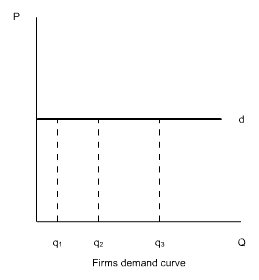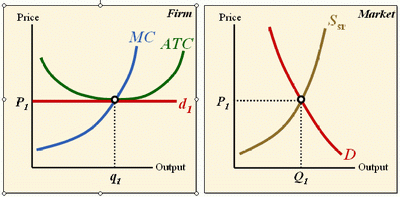Do you want BuboFlash to help you learning these things? Or do you want to add or correct something? Click here to log in or create user.
Subject 2. Perfect Competition
#cfa #cfa-level-1 #economics #has-images #microeconomics #reading-16-the-firm-and-market-structures
An industry with perfect competition displays the following characteristics:



- All the firms in the market are producing an identical product (e.g., wheat of the same grade).
- No barriers limit the entry or exit of firms in the market.
- A large number of firms exist in the market. Established firms have no advantages over new ones.
- Sellers don't have market-pricing power.
- There is no non-price competition.
Perfect competition arises:
- When a firm's minimum efficient scale is small relative to market demand so there is room for many firms in the industry, and
- When each firm is perceived to produce a good or service that has no unique characteristics, so consumers don't care which firm they buy from.
The demand analysis in perfectly competitive markets is covered in Reading 13.
The supply analysis, optimal price and output, and long-run equilibrium in perfectly competitive markets are covered in Reading 15.
In perfect competition, each firm is a price taker. Price takers are sellers who must take the market price in order to sell their products.
- There is no price decision to make: they will merely attempt to choose the output level that will maximize profit.
- Each price taker's output is small relative to the total market: the output of a firm exerts little or no effect on the market price.
This diagram represents the market demand and supply curve for a certain product - for example, eggs.

As usual, the intersection of the demand and supply curve creates the market price (P) per egg. Now remember that a firm that is a price taker can sell all it wants to at that price, but can sell nothing at a higher price.

Price takers can sell all their output at the market price, but they are unable to sell any of their output at a price higher than the market price. That is, a price taker faces a horizontal demand curve. Each firm's output is a perfect substitute for the output of the other firms, so the demand for each firm's output is perfectly elastic.
- They can sell as much as they would like at the going market price.
- There is no need for them to reduce their price in order to sell more.
- Moreover, at any price above the market price there is no demand; their sales would be zero (nobody would buy from that firm because there are so many other firms from which to obtain the product at the market price).
- This reflects the fact that perfectly competitive firms have no control over their price.
When a perfectly competitive market is in long-run equilibrium:
- Quantity supplied and quantity demanded must be equal in the market.
- Firms in the market must earn zero economic profit at the prevailing market price (that is, firms are earning the "normal rate of return"). This occurs when market price = marginal revenue = marginal cost = minimum ATC. Note that accounting profits may still be positive.

Why do firms earn zero economic profit in the long-run equilibrium?
- If firms earn positive economic profit in the long-run equilibrium, these firms will have an incentive to expand their capacity, and new firms will enter the market. This will lead to an increase in supply, forcing the market price down until economic profit is eliminated.
- Conversely, if firms in the market incur economic losses, some firms will leave the market. Accordingly, supply will decline, causing the market price to rise until existing firms can earn the normal rate of return (that is, economic profit is zero).
If you want to change selection, open original toplevel document below and click on "Move attachment"
Summary
| status | not read | reprioritisations | ||
|---|---|---|---|---|
| last reprioritisation on | suggested re-reading day | |||
| started reading on | finished reading on |
Details
Discussion
Do you want to join discussion? Click here to log in or create user.